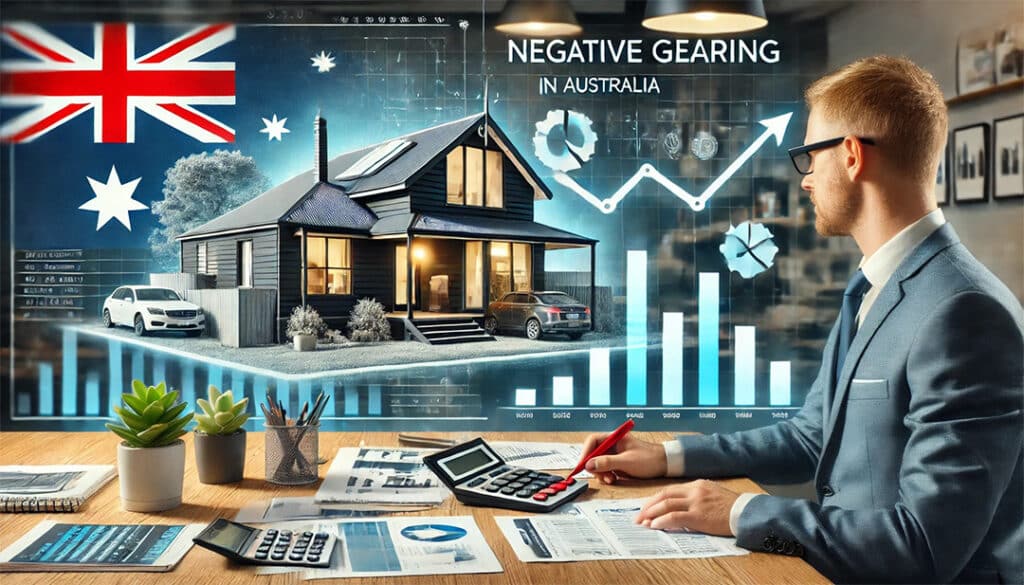Understanding how negative gearing works can be the difference between building long-term wealth through property or falling into a financial trap.
While the term might sound technical, it’s a widely used strategy among Australian investors — and if done right, it can significantly reduce your tax bill while positioning your portfolio for growth.
What Is Negative Gearing and Why It Matters
Negative gearing is when you purchase an investment property and the total expenses exceed the rental income it generates.
In simpler terms, you’re losing money on purpose — with a tax advantage in mind.
“Negative gearing is when a multiple property owner says to the ATO, ‘Hey, look, I spent more money on my investment properties than I got back in rent, so I’m going to offset that loss against my salary and pay less tax.’”
This strategy is particularly popular in Australia, where tax laws allow such losses to be claimed as deductions — reducing your taxable income and your overall tax payable.
How Does Negative Gearing Work?
Let’s break it down with real numbers:
“Let’s say you earn $100,000 per year, and your tax rate is 30%.
You buy an investment property that earns $500/week in rent, but costs $600/week in expenses.”
That’s a $100 weekly loss, or $5,200 annually.
You can offset that against your salary:
- $100,000 – $5,200 = $94,800 taxable income
- At 30% tax, that’s $1,560 in tax savings
“So even though you lost $5,200 on paper, you’re getting $1,560 back in your tax return.
Your ‘real’ loss is more like $3,640.”
Benefits of Negative Gearing for Property Investors
Beyond tax deductions, negative gearing allows investors to hold properties in high-growth areas with long-term upside.
“Negative gearing works in a market where property values are going up.
While it might cost you $5,000 a year to hold a property, if it increases $50,000 in value, you’re ahead.”
And when depreciation is added in, your paper losses increase — boosting your tax benefits without needing to spend more cash.
Negative Gearing Example (Simple Breakdown)
- Rental Income: $500/week = $26,000/year
- Expenses: $600/week = $31,200/year
- Net Loss: $5,200/year
“This $5,200 can be offset against your salary.
If you earn $100K, your taxable income drops to $94,800 — saving around $1,560 in taxes.”
How Depreciation Impacts Your Tax Position
One powerful but overlooked factor in negative gearing is depreciation.
“Let’s say you build a new home for $300,000.
You may be able to depreciate 5% per year — that’s $15,000 in tax deductions.”
Combined with your rental loss:
- Salary: $100,000
- Rental loss: -$5,200
- Depreciation: -$15,000
- Taxable income: $79,800
“This extra $15,000 lowers your tax bill dramatically — possibly saving you over $6,000.
In some cases, this turns a negatively geared property into a positive cash flow investment after tax.”
Negative Gearing vs Positive Gearing
- Negative gearing: Expenses > Rental income → Loss offsets income
- Positive gearing: Rental income > Expenses → Property generates a net profit
“Positive gearing means you’re not relying on tax deductions — the property stands on its own.
But the trade-off is usually slower capital growth.”
Is Negative Gearing Risky or Sustainable?
There’s an ongoing political and economic debate around this strategy.
“It’s not about growing a business; it’s about losing money to reduce taxable income…
and it distorts the housing market.”
Critics argue it inflates prices and benefits the wealthy. Supporters say it helps meet housing demand and supports the rental market.
“Modelling by PIPA shows that removing negative gearing could gut the rental market
and cost the government billions in lost revenue.”
Political Debate: Reform or Retain?
The topic has come up in several federal elections. Some policies proposed limiting negative gearing to new builds only.
“Labor’s 2019 policy would have increased supply and potentially lowered prices by 5–12%,
but it also scared investors and contributed to the current rental shortage.”
“Yes, many doctors and lawyers negative gear. But so do nurses and teachers — just on a smaller scale.”
Final Thoughts: Is Negative Gearing Right for You?
Negative gearing isn’t for everyone. It’s best suited to:
- Investors with stable incomes
- Those focused on capital growth
- People comfortable with short-term cash flow losses
“It’s not a property strategy — it’s a tax result.
But if used smartly, it can increase your cash flow and help you build long-term wealth.”
Before acting, always consult a tax professional and make sure the strategy aligns with your financial goals and risk profile.
